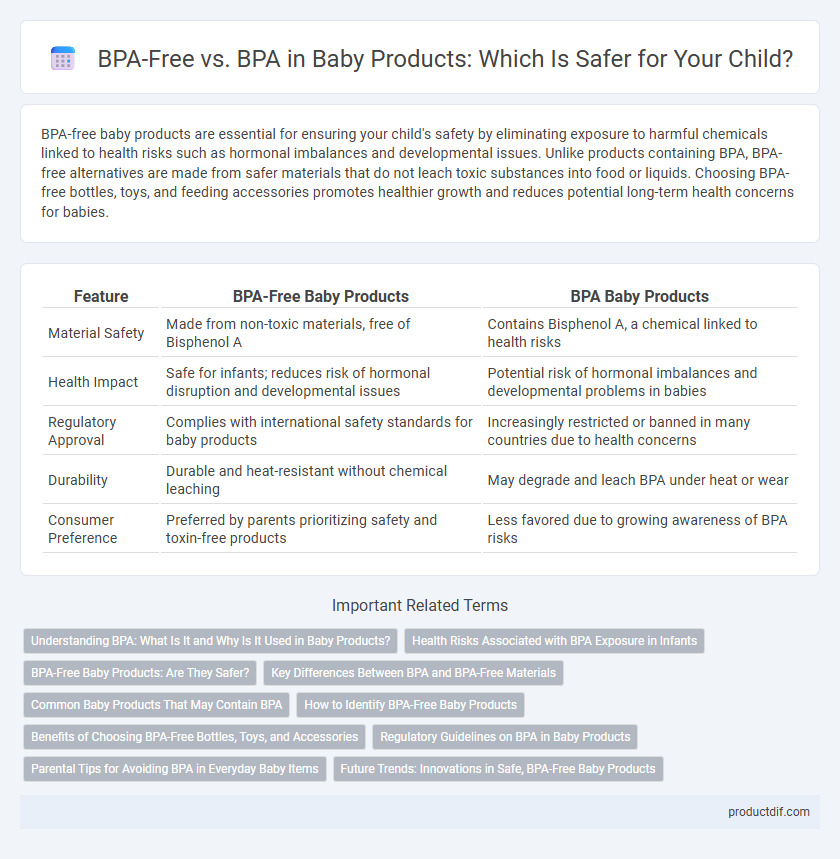BPA-free baby products are essential for ensuring your child's safety by eliminating exposure to harmful chemicals linked to health risks such as hormonal imbalances and developmental issues. Unlike products containing BPA, BPA-free alternatives are made from safer materials that do not leach toxic substances into food or liquids. Choosing BPA-free bottles, toys, and feeding accessories promotes healthier growth and reduces potential long-term health concerns for babies.
Table of Comparison
| Feature | BPA-Free Baby Products | BPA Baby Products |
|---|---|---|
| Material Safety | Made from non-toxic materials, free of Bisphenol A | Contains Bisphenol A, a chemical linked to health risks |
| Health Impact | Safe for infants; reduces risk of hormonal disruption and developmental issues | Potential risk of hormonal imbalances and developmental problems in babies |
| Regulatory Approval | Complies with international safety standards for baby products | Increasingly restricted or banned in many countries due to health concerns |
| Durability | Durable and heat-resistant without chemical leaching | May degrade and leach BPA under heat or wear |
| Consumer Preference | Preferred by parents prioritizing safety and toxin-free products | Less favored due to growing awareness of BPA risks |
Understanding BPA: What Is It and Why Is It Used in Baby Products?
BPA, or bisphenol A, is a chemical commonly used to harden plastics and line metal cans in baby products for durability and safety. Research links BPA exposure to potential health risks, including hormonal disruptions and developmental issues in infants. Choosing BPA-free baby products reduces these risks by avoiding materials containing this synthetic compound.
Health Risks Associated with BPA Exposure in Infants
BPA (Bisphenol A) exposure in infants has been linked to significant health risks including hormonal disruptions, developmental problems, and increased susceptibility to certain chronic diseases. Baby products labeled BPA-free eliminate this chemical, reducing infants' exposure to potential toxic effects, thereby promoting safer growth and development. Choosing BPA-free options is essential for protecting infants from endocrine system interference and long-term health complications.
BPA-Free Baby Products: Are They Safer?
BPA-free baby products eliminate exposure to bisphenol A, a chemical linked to hormone disruption and developmental issues in infants. Studies show that BPA-free materials, such as polypropylene and silicone, provide safer alternatives for bottles and feeding accessories. Choosing BPA-free options reduces the risk of health complications, making them a safer choice for baby care.
Key Differences Between BPA and BPA-Free Materials
BPA (Bisphenol A) is a chemical commonly found in plastics that can leach into baby products and interfere with hormone function, posing health risks to infants. BPA-free materials are made without this chemical, reducing the risk of endocrine disruption and making them safer for baby bottles, teethers, and toys. Choosing BPA-free products ensures reduced exposure to harmful chemicals, promoting safer developmental environments for babies.
Common Baby Products That May Contain BPA
Common baby products that may contain BPA include plastic bottles, sippy cups, pacifiers, and food storage containers made from polycarbonate plastics. BPA, or bisphenol A, is an industrial chemical used to harden plastics but can leach into liquids, potentially affecting infant health. Opting for BPA-free alternatives ensures safer feeding and storage options, reducing exposure to harmful chemicals linked to developmental and hormonal issues.
How to Identify BPA-Free Baby Products
To identify BPA-free baby products, check the packaging and labels for clear BPA-free certification or symbols such as "BPA-free" printed by reputable brands. Look for products made from safe materials like silicone, glass, or polypropylene, which typically do not contain BPA. Avoid plastics marked with recycling codes 3 or 7, as these may contain BPA, and opt for alternatives labeled with recycling codes 1, 2, 4, 5, or silicone-based materials for safety.
Benefits of Choosing BPA-Free Bottles, Toys, and Accessories
Choosing BPA-free bottles, toys, and accessories significantly reduces infants' exposure to harmful chemicals linked to developmental and hormonal disruptions. BPA-free products are made from safer materials such as polypropylene or silicone, ensuring toxins do not leach into baby food or drinks. Opting for BPA-free options supports healthier growth and gives parents peace of mind regarding their child's safety and well-being.
Regulatory Guidelines on BPA in Baby Products
Regulatory guidelines on BPA in baby products emphasize strict limits or complete bans on bisphenol A due to its potential health risks, particularly endocrine disruption in infants. Agencies such as the U.S. Food and Drug Administration (FDA) and the European Chemicals Agency (ECHA) have established prohibitions on BPA-containing materials in baby bottles and sippy cups, promoting BPA-free alternatives. Compliance with these regulations ensures safer baby products, reducing infant exposure to harmful chemicals and supporting overall child health safety.
Parental Tips for Avoiding BPA in Everyday Baby Items
Choose baby bottles, sippy cups, and feeding utensils labeled BPA-free to reduce exposure to harmful chemicals linked to developmental issues. Opt for products made from glass, stainless steel, or BPA-free plastics and avoid heating plastic containers in microwaves, as heat can increase chemical leaching. Regularly check product labels and recalls to ensure baby items comply with safety standards and minimize BPA risks in everyday use.
Future Trends: Innovations in Safe, BPA-Free Baby Products
Future trends in baby products emphasize innovations that ensure complete safety by eliminating BPA and adopting advanced, non-toxic materials like Tritan and medical-grade silicone. Manufacturers are increasingly integrating smart technology to monitor bottle temperature and cleanliness, enhancing product safety while maintaining BPA-free standards. Regulatory bodies worldwide are pushing for stricter safety certifications, driving the industry toward transparency and the widespread adoption of eco-friendly, BPA-free solutions.
BPA-free vs BPA Infographic

 productdif.com
productdif.com